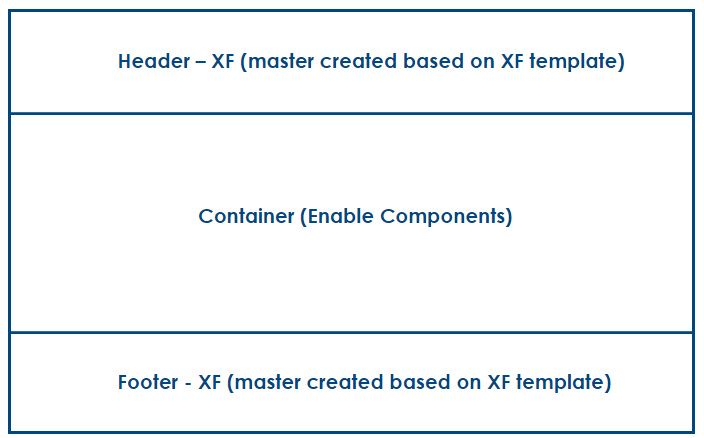Some of my last posts explained the Website Structure in AEM — Multi-Site Manager(MSM), Reusing the same template across multiple websites; in this post, let us discuss the Editable Template Strategy to support the multi-sites on the AEM platform.

The below questions asked when the AEM projects adopt the Editable templates.
- How many editable templates are to be created?
- How to organize the editable template?
- Who manages the editable template?
- Can we reuse the editable templates across multiple
You can have quite flexible, very rigid templates, or somewhere in between. Adobe does not recommend having more than 1000 templates due to potential performance impacts. Here are a few keynotes to consider when developing this crucial building block:
- The unique structure and initial content requirement
- Page properties — Page priorities on different page types, e.g., root page, product page, etc
- Policy Variations
- Style System Variation
- Allowed Components
- Theming variations — Supporting different themes.
- Reusability
- Impact — a dynamic connection between the page and the template is maintained; changes to the template structure will reflect any pages created with that template (initial content changes will not reflect).
- Access management
Template Strategy:
You should be able to adopt any number of Editable template strategies; some of them are below.
Global Templates — Templates that all the sites hosted in AEM can use e.g
- Root Template — Template to create root pages of a website
- Content Template — Template with a default header and footer and empty container between header and footer for authoring
- Empty Template — Empty template with the container to author the components.
- Product Template — Template to support the product pages
Region Specific Templates — In some cases, we may need a region-based template to manage region-specific changes or better access management of the templates. The same global templates can support the region-specific needs, but this will helps to isolate the impacts on region-based websites by the changes on the global templates.
Category Specific Templates — Templates to support specific categories, e.g., microsites. We can use the same global templates to support the microsites, but this helps isolate the impacts on category-based websites by the changes on the global templates.
Site-Specific Templates — Templates to support site-specific needs, site-specific unique structure, and initial content needs; this template is not a global need but to help specific sites.
Template Management:
Template management is another critical factor; who manages the editable templates Development team vs. template-authors, also manage through code repository vs. directly through template editor.
Dev Managed:
- The dev team only manages templates/policies
- Enable the changes through deployment; the source of truth is the git repo
- Still enable a back sync from production author back to code repo to sync any changes enabled directly in prod author
The benefit of this approach is the changes are moved through deployment, which is useful when the team doesn’t include experienced authors to manage the templates. But the concern is dev dependency to enable any template changes — more helpful when the ongoing changes are limited.
Template Authors Managed:
- Template authors manage the templates directly in prod author
- Enable the changes directly through prod author; the source of truth is the prod author
Still enable a periodic back sync from production author back to code repo to reflect the changes in other environments. This approach will enable the required flexibility to the template authors to manage the template changes; also periodic sync to the code repository to ensure the backup of changes.
Page component:
The Editable Templates are always created based on a Page Component and template type. Whenever possible, ensure the same page component is used to create the templates — some cases exception to create own page components to support unique scenarios.
This will helps you to have complete control over dialogs(use render conditions to manage the display for specific cases), metadata, and other common elements.
Guidelines:
- Restrict the templates to specific content paths
- Training for template authors — Ensure the template authors are aware of the Editable template management, mainly the dynamic relationship between the Editable templates and the pages created through that — any change in the editable templates(apart from the initial content will impact the existing pages.
- Enable the required access management for editable templates — ensure only the specific people (template-authors) have access to manage the editable templates.
- Never enter any information that needs to be internationalized into a template. For internalization purposes, recommended using the localization feature of the Core Components.
- Ensure template guidelines are created for authors — this will guide the template authors to use the suitable template for page creation.
- Allow only the components enabled for authoring.
Templates simplify your page creation workflow. However, too many templates create management overheads. Also, too few templates can lead to issues like global impact on template changes. A good rule of thumb is to keep the number of templates as minimal as possible by considering all the key factors discussed above (maybe below 100 ).
The static templates are still supported but use editable templates when starting building new projects. Also, migrate editable templates whenever undergoing significant changes in the current experience. But still can use the existing editable templates. There is no hard rule to migrate all the static templates to editable templates but migrating whenever possible as an Editable template is the recommended approach from Adobe.
AEM also now supports Quick Site Creation, creating a site very quickly using a quick site creation template — this will use the Editable templates and core components to create sites. Refer to Quick site creation | Site Template in AEM(Adobe Experience Manager) for more details on Quick Site Creation.
No comments:
Post a Comment